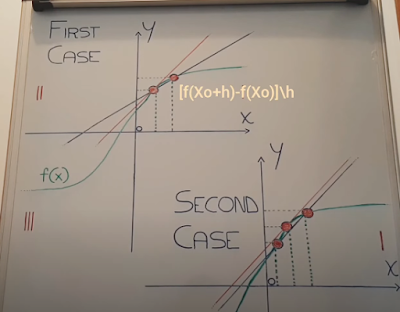Nicolò Vignatavan - Limit definition of derivative
DERIVATIVES: the limit definition
Nicolò Vignatavan
-> Video
According to
traditional mathematics, the derivative of a function at one of its points
"Xo" is
infinitesimally
equivalent to the incremental ratio [f(Xo + h) - f(Xo)] / h, with "h"
meaning "Delta x", or
in other
words, the difference between the
abscissa of the upper extremity, in direction x of the
segment of
dimension "h", constructed starting from "Xo" and the same
lower extremity point
"Xo"
and "[f (Xo + h ) - f (Xo)] "
is understood as " Delta y
", with " f (Xo + h) "
and " f (Xo)
considered
respectively as the images on the axis of the ordinates of the two extreme
points in
denominator,
with h tending to 0.
In these
terms, assuming a secant line to the function precisely at the ordinate points
"f (Xo +
h)" and
"f (Xo)", considered as the intersections of the same function with
the extremes of the
closed and
derivable interval "x" in which it is analyzed, in the instant in
which h tends
infinitesimally
to 0, the line becomes tangent to the function at the point "Xo". The
slope of this
line, at the
moment of tangency, is defined as the numerical value of the derivative at this
point.
If h were
equal to 0, the straight line would separate from the function, moving
externally. Now
let us assume
that along the abscissa axis, instead of constructing towards segment
"x", we
construct a
segment "h" starting from point "Xo", and we set a circular
neighborhood of point
"Xo"
with a dimension of "2h", constructing by starting from the
"Xo" point, along the x axis,
a segment
"h" in the -oo direction and another of the same length at the + oo
direction. In this
way, the
incremental ratio will result to be [f
(Xo + h) - f (Xo - h)] / 2h.
If in the
first case the secant line, where h tends to 0,
becomes tangent to the "Xo" point by
rotating itself, since one end is a fixed constraint
and the other is mobile, in the second case, it
first presents
itself as a circular neighborhood of the point "Xo", therefore, two
equivalent "h"
distances
along the x axis, the secant line becomes tangent not only by rotating itself, but also
by varying
ordinate, whose angular coefficient will be, at the end of the movement, that
of the
line tangent
to the point "Xo".
For this
reason, in my opinion, this second approach is the most complete to define the
concept
of a
derivative.

Commenti
Posta un commento